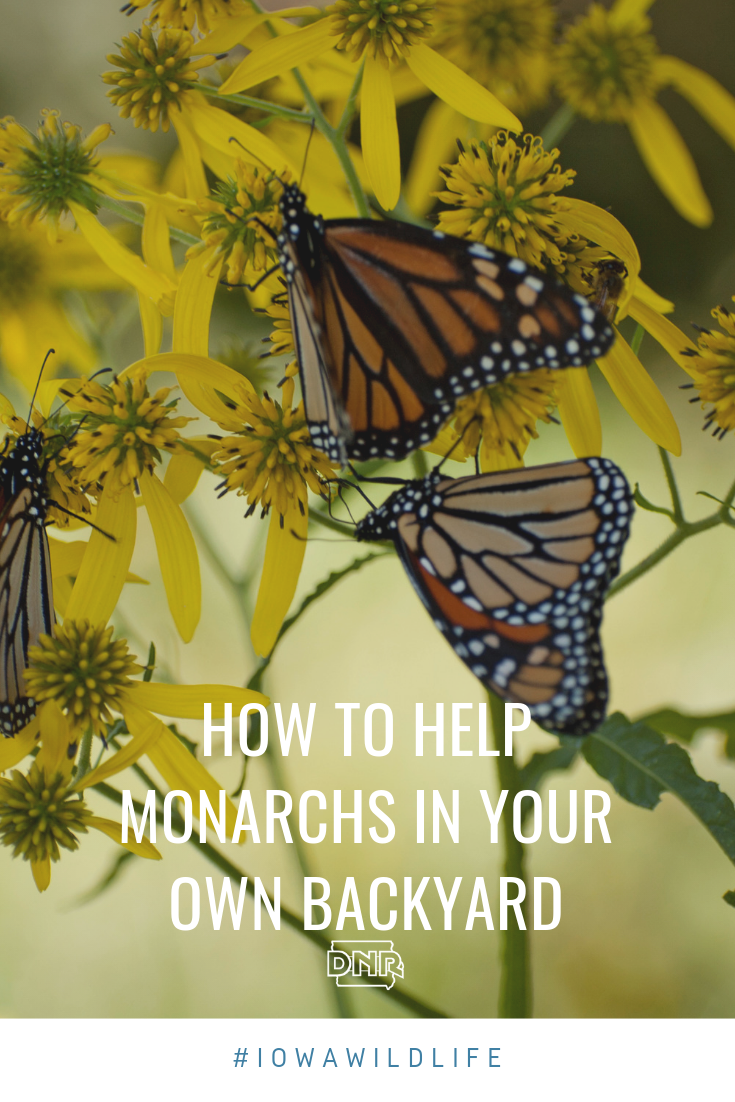One of the most recognized pollinators, monarchs travel more than 3,000 miles each year to come visit Iowa for the summer. With declining numbers over the last decade, here are some ways you can help these beautiful orange and black butterflies:
Create a pollinator garden
Gardens help not only monarchs, but other butterflies and pollinators, like bees. Whether your garden will take up a few square feet or a few acres, monarchs benefit from any amount of help.
 When deciding where to put your butterfly sanctuary, look for a sunny spot that has protection from the wind. You should also check your soil to make sure you choose plants that can thrive in the space.
When deciding where to put your butterfly sanctuary, look for a sunny spot that has protection from the wind. You should also check your soil to make sure you choose plants that can thrive in the space.
Monarchs must have milkweed to survive. They lay their eggs on the plant and it’s the only plant that the caterpillars eat to grow. Have at least one type of milkweed in your garden, along with at least three different plants in bloom at all times from early spring to late fall, so something is always available for monarchs and other pollinators.
Choose native plants, trees and shrubs. These plants are adapted to Iowa’s environment and require less maintenance and can better tolerate Iowa’s unpredictable summer weather.
Play it safe
Pesticides can be harmful to many kinds of wildlife, including monarchs. Avoid using chemicals as much as possible — the Good Neighbor initiative suggests not spraying to be a better neighbor. If it’s necessary to use pesticides, follow the instructions exactly and in as targeted a fashion as possible. Keep this in mind when choosing plants, as well. Avoid plants that have insecticides incorporated in the plant material.
Keep it natural
Even though many people prefer a well-groomed yard, perfectly manicured lawns tend to be close to a biological desert. To help butterflies and other wildlife, let your yard get a little weedy. Violets, dandelions and clover benefit pollinators. If you’re a rural land owner, try to avoid mowing your ditch to allow wildflowers and milkweed to flourish.
If you’re okay with some mess, create a small prairie patch in your yard. You can add edging to create a distinct area, while keeping things neatly mowed around the patch. If you’re not able to plant a prairie, don’t worry — monarchs also appreciate formally planted gardens.
Add to the oasis
Aside from planting, you can help monarchs by providing resting spots. These insects enjoy basking in the sun, so adding flat rocks in a sunny spot creates the perfect basking spot. Make your bird bath pollinator friendly by creating a puddling area. Add gravel to create a shallow spot for monarchs and bees to rest, soak up sunlight and get some water without drowning.
Start a trend
When starting your butterfly garden journey, check out what’s already in your neighborhood and do your best to complement it. If your monarch sanctuary will be the first in your area, talk to your neighbors about creating their own. Becoming an ambassador and spreading the word about helping monarchs is a great way to help. You can even register your garden with Plant.Grow.Fly. through the Blank Park Zoo.
Become a citizen scientist
If you’re not a gardener, or if you’d like another way to help monarchs, become a citizen scientist. You can order wing tags from Monarch Watch and tag the butterflies to help scientists track the monarch migration. If you’re interested in going out in the field, you can take part in the Integrated Monarch Monitoring Program. This program collects data used to help conservation efforts for monarchs.